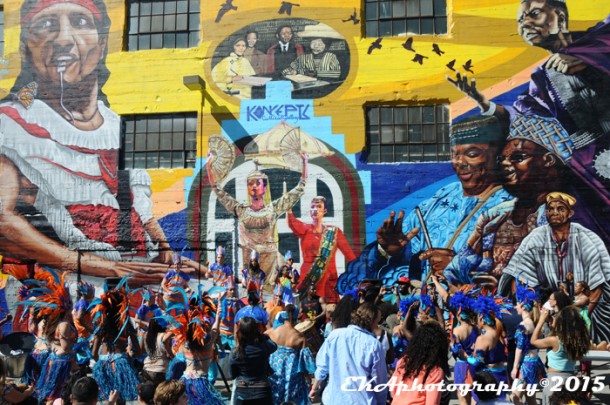
Oakland’s Malonga Arts Center is known for the sounds of drumming and dance emanating from within; this past Saturday, those sounds came from the parking lot across the street.
Culminating a project two years in the making, Oakland-based cultural arts collective Community Rejuvenation Project (CRP) celebrated the completion of Phase II of its Alice Street Mural Project with a vibrant, joyous block party June 6, held in the parking lot at Alice and 14th Sts., surrounded by the project’s four colorful, character-driven walls.
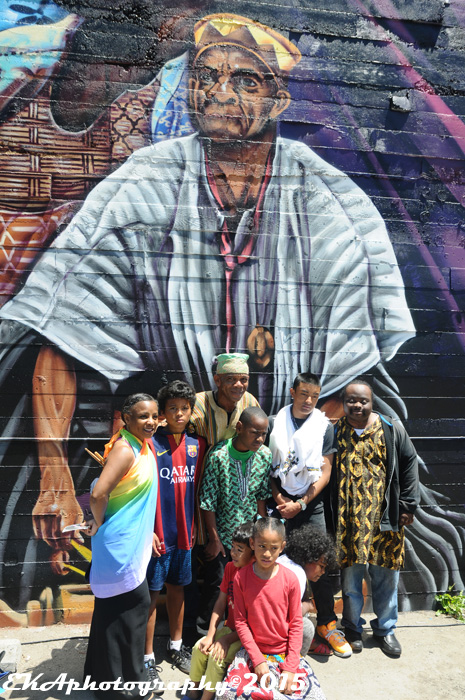
Tacuma King with Bay Area Youth Arts
Approximately 400 cans of aerosol paint and six weeks of painting time went into the final wall, which rises a towering 40 feet in height. Where previously, the wall had been a blighted eyesore detracting from the world-class dance, theater, and music being produced out of the Malonga Center, the mural now pays visual tribute to African, Brazilian, Afro-American, Filipino and Chinese arts practitioners.
Many of the figures on the wall (as well as several culture keepers and community leaders painted during 2014’s Phase I) were in attendance, which made the occasion even more auspicious.
There were many highlights throughout the afternoon.
Host/MC Carla Service introduced Tacuma King, co-founder of Children in Flight and Bay Area Youth Arts – a founding organization of the Malonga Arts Collective–, who opened up the proceedings with his young drum disciples.
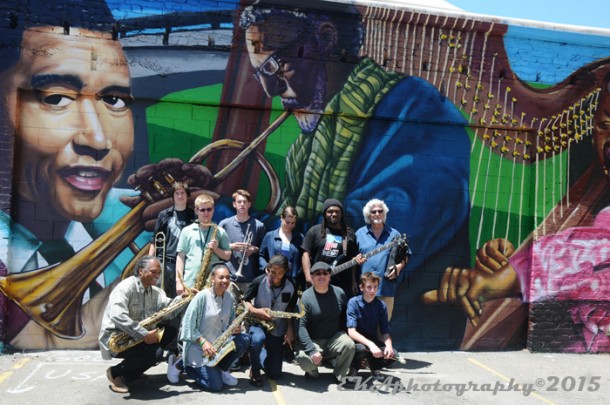
Oaktown Jazz Workshops
Oaktown Jazz Workshops , headquartered for many years at the Malonga Center, followed with an extended jazz set dedicated to their founder, the late Kahlil Shaheed (also tributed during Phase I).
Ohlone tribe member Luta Candelaria then acknowledged the indigenous ancestors of the Bay Area, Huchiun Ohlones who spoke the Cocheño language, with native songs honoring the four directions. At their conclusion, he remarked, “welcome to Ohlone territory.”
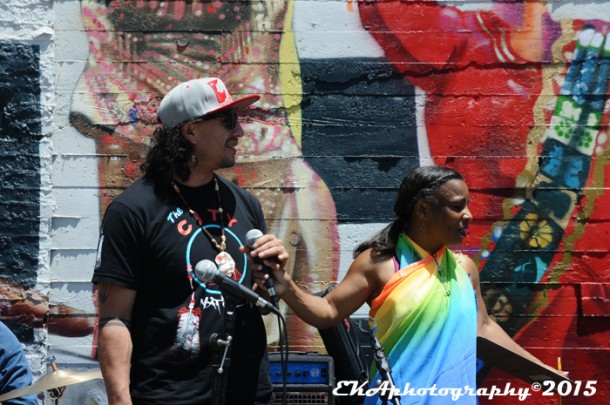
Luta Candelaria and Carla Service
Candelaria also spoke a bit about the image of Tony Cerda, chief of the Costanoan Rumsen Carmel tribe of Ohlone, which graces Phase I’s leftmost side. Candelaria explained that the Bay Area’s Ohlone population were largely displaced from their indigenous lands—which ranged from San Pablo Bay in the North to Año Nuevo in the South —and relocated to Southern California. Cerda, he said, has been instrumental in “helping to keep our language, helping to keep our dances and songs alive.” It’s an honor, he said, to be able to present this mural on behalf of our “spiritual uncle Tony.”

Judith Smith of AXIS Dance Company
AXIS Dance Company Artistic Director Judith Smith thanked CRP for “highlighting the diversity and the arts that are happening right here in Oakland.” Noting that AXIS has been around for 28 years, the past 14 based out of the Malonga Center, she added that “Oakland has a history of supporting the arts and [is] a really great center… for the inclusion of people with disabilities… It’s wonderful to be able to go into a building and see so many of the people on this mural every single day.”
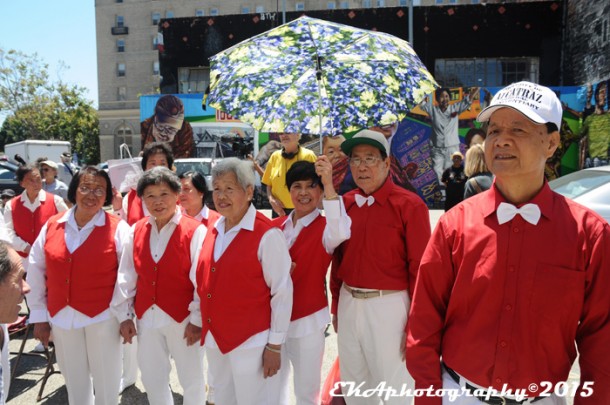
Hotel Oakland Choir and Dancers
Service noted that the mural represents not just the Malonga Center, but also the “Chinese brothers and sisters of the Hotel Oakland,” and introduction to the red-and-white suited Hotel Oakland Choir and Dancers, who offered up a demonstration of traditional Chinese-style line dancing. Sam Tsang, the senior community center’s resident flutist, who serenaded CRP lead artists Desi and Pancho every morning as they arrived to paint, followed next.

Sam Tsang
City of Oakland Cultural Arts Dept. staffer Denise Pate then spoke about the mural. Pate noted the many hoops CRP had to jump through to complete the project and that she recognized many of the people pictured in the mural. “This is a real beautiful chronicle of our arts and social justice and cultural richness in the city of Oakland,” she said.
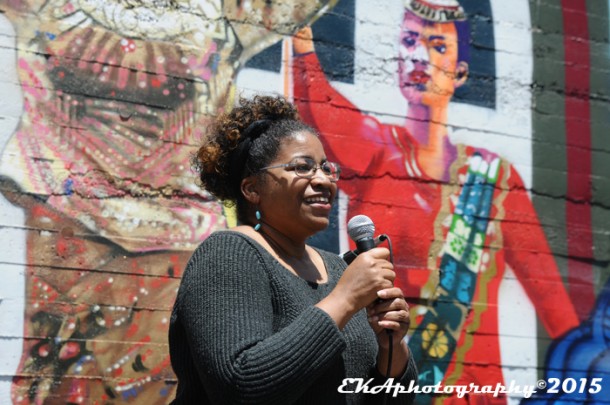
Denise Pate of the Cultural Arts Department
The next speaker was Alice Arts Center co-founder Halifu Osumare, who shared anecdotes about her dance troupe, City Center Dance Theater/Everybody’s Creative Arts Center. She noted that the image of her pictured on the wall was from her time in Ghana, where she was inspired to start her company.
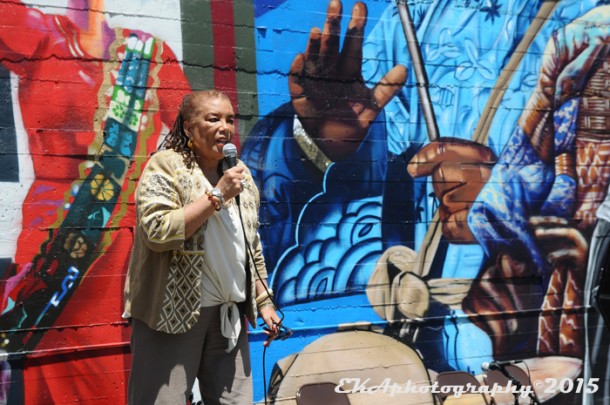
Halifu Osumare
“We always stand on the shoulders of those who have come before, and several people are represented on this [mural] who are now ancestors,” she said. “Of course, the name of Malonga Casquelourd comes to mind, the namesake of our building… so many creative artists who have come through this center.”

CRP’s Pancho and Desi with Halifu Osumare and Naomi Diouf
The mural, she said, “represents that energy that we started,” adding that “the beauty of the African Diaspora” has been passed down to “at least three generations.” The project, she said, “shows how the visual arts and the performing arts can really make a synergy and a community come together.”
Osumare then introduced Ruth Beckford—inspiration for one of the mural’s largest characters—who she said “can rightfully be called the mother of Black dance in the East Bay.”
Beckford, dressed in a colorful yellow suit, still looked quite spry at age 89. “Usually, when people get this type of recognition, they’ve already turned their toes up fifty years ago and can’t even see what they’re being honored for,” she said. “I’m happy to see myself on a wall. I have never been on a mural before, so I got a little swell-head going on right now.” She shared that the image shows her performing an Afro-Haitian dance, and urged attendees to “keep dancing.”
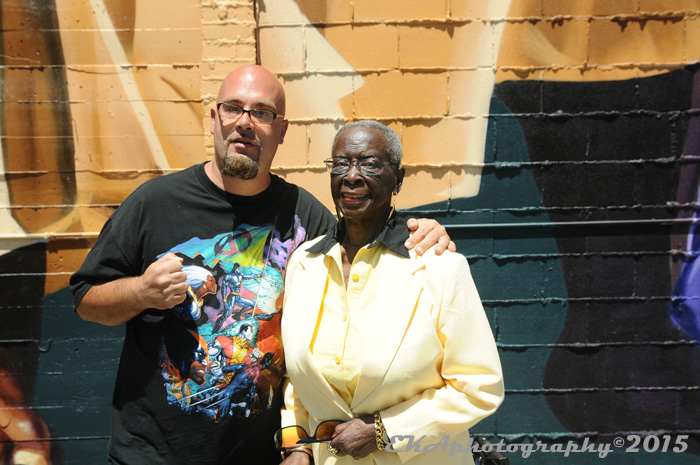
Desi Mundo and Ruth Beckford
Two more of the mural’s characters, Papa Zac Diouf and Mama Naomi Diouf, were pointed out by Service, who then brought Zac to the stage. He recalled coming to the US in 1963 as the Artistic Director of the National Dance Company of Senegal, Mali and Guinea, and returning this country two years later at the behest of Katherine Dunham. His company Diamano Coura, he noted, was formed 40 years ago, in 1975; since 1987, they’ve been centered at Malonga. Zac noted that the building was specifically intended for the African community by former mayor Lionel Wilson; “that’s why Jerry Brown could not take this building from us,” he said. “We fought for it, and we really appreciate it.”
The Dioufs and Diamano Coura then threw down with their expert-level West African dance/drumming, pulling people out of the crowd to join in the dance.
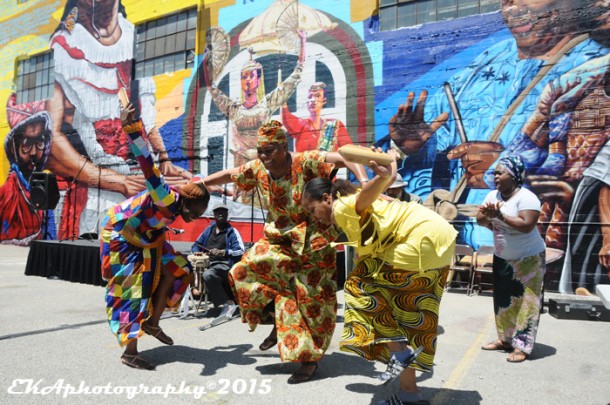
Diamano Coura
Actor and cultural activist Michael Lange (RIP), the final character added to the wall, was eulogized by Gerald Reece, who noted his association with the building dates back to 1985. Reece explained that Lange stepped in as building manager following the attempted eviction by Brown in 2003, and settled what had been an atmosphere of anger, mistrust and suspicion. “Michael would just listen… in his dealings with people, he was always on an even keel… he was more like an artist who was managing the building… he got to know every tenant by name, he went to every class.” More than anything, Reece said, “today is a tribute to him.”
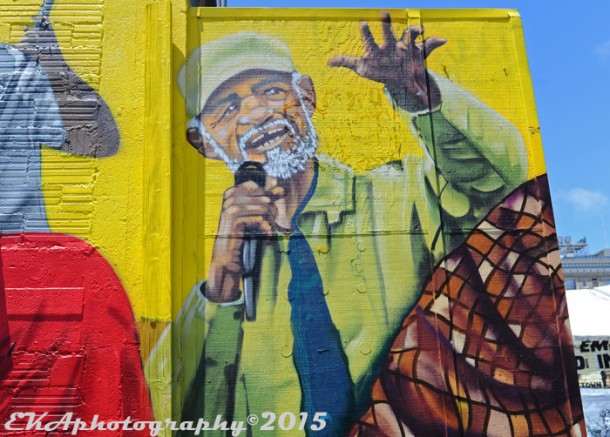
Rest in Power Michael Lange
Following Reece, Dance-A-Vision dancer Najah Miller performed a powerful solo piece affirming pride in blackness. Offered the mic by Service, Miller related how she started dancing at the Malonga Center at the age of 11. “Malonga has been a family area for me to come back to. I know that it will always be here for me,” she said.
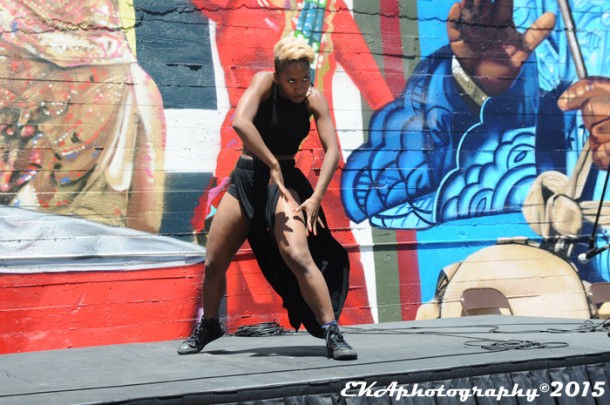
Najah Miller
SambaFunk’s King Theo related the historical progression of samba in Oakland, beginning with Escola do Samba Batucaje – the first such organization of its kind in the United States—and continuing with SambaFunk. Samba Batucajae, he said, “is the origin and the root of it all. We talk about the tree, we talk about the limbs, we talk about the leaves, we talk about the fruit, but very seldom do we recognize the root.”
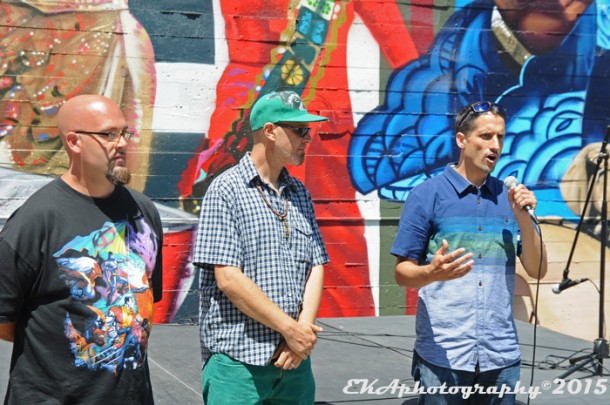
CRP’s Desi Mundo, Pancho Peskador and Spencer Wilkinson
CRP founder/Executive Director Desi Mundo, co-lead artist Pancho Peskador, and documentary filmmaker Spencer Wilkinson all spoke about their experiences in making the mural coming to life. “For the past two years, [CRP has] been focused on trying to tell the story well, by doing the research on the community, by interviewing many of the members of the community, to really learn about the story,” Wilkinson said. “I’m very proud of the work and will keep working for the people always,” said Pancho. “We hope to do many more of these projects where we can continue to represent for Oakland and tell the history of things that have happened here,” said Desi.
Gift Harris then read a poem for Michael Lange, “Be Like Mike,” in which implored the audience to “do your very best as you live this life.”
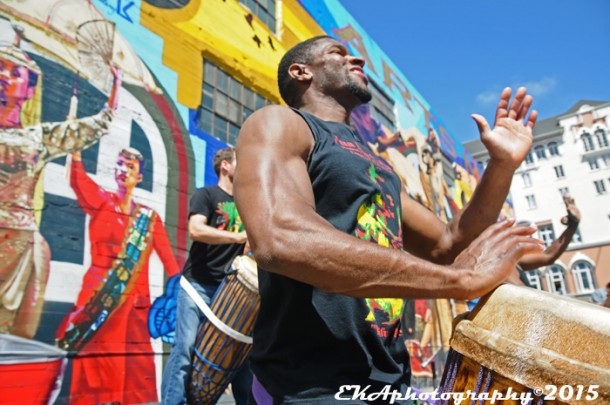
Kiazi Casquelourd, son of Malonga
Then came Kiazi Casquelourd aka Kiazi Malonga, son of Malonga Casquelourd, who had just finished teaching a class at the center named for his father. Kiazi helmed a drum trio which displayed the Congolese style of African drums.

Kiazi Casquelourd’s Congolese drum trio
After a break, the parking lot was suddenly filled with the blue and orange uniforms of Fogo Na Roupa, the Brazilian dance troupe founded by the late Carlos Aceituno, and now led by Jose Rivera. Both Aceituno and his mentor, Samba Batucaje’s Jose Lorenzo, are depicted on the wall.
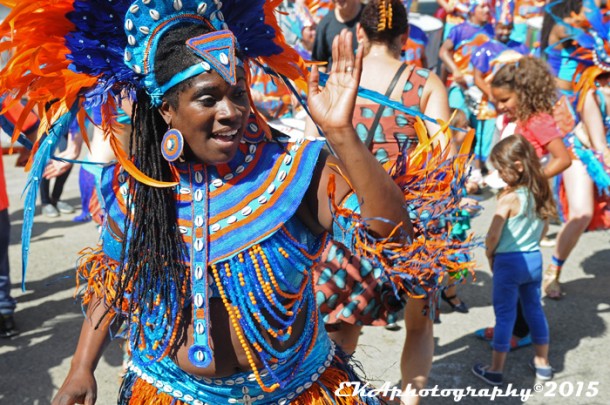
Fogo Na Roupa
Fogo Na Roupa went all out, bringing Carnaval to Oakland in June. As Rivera and a backline of drummers kept the beat steady, wave after wave of dancers entered in succession. From an observer’s point of view, it was revelatory to see the pioneering Afro-Brazilian dance company—long since relocated to San Francisco—back in Oakland.
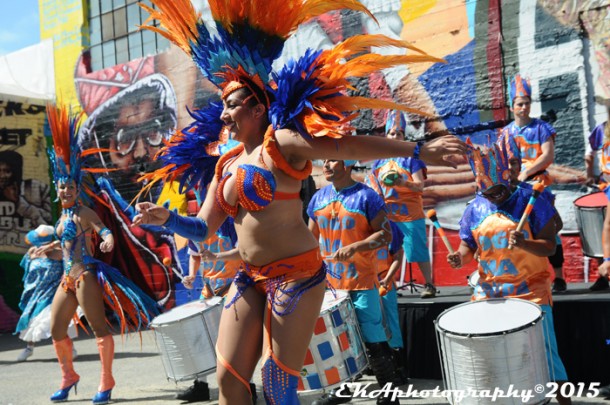
Fogo Na Roupa
By the end of Fogo’s performance, nearly everyone in the crowd had become a participant in the dance. It was a fitting way to end an afternoon which transformed a bland parking lot into a cultural space, while perfectly illustrating the central themes of the mural: celebrating movement, multiculturalism, culture-keeping, and rhythmic expression.
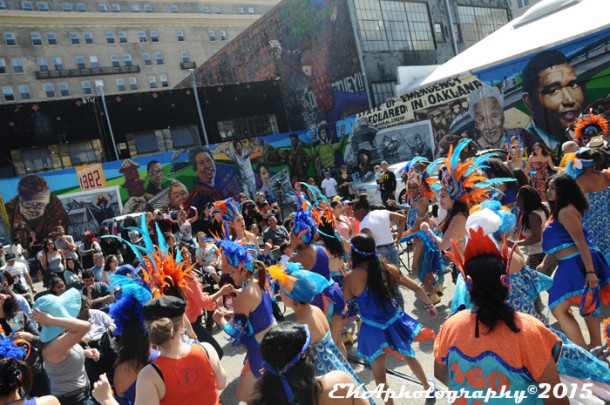
Fogo Na Roupa
Looking back at the two-year journey to realize the Alice St. Mural, it’s been an amazing ride for everyone here at CRP. The process has taught us more about neighborhoods, community, and Oakland history than we ever could have imagined and has positively changed our perceptions of what public art can and should be. While it was challenging, at times, to deal with some of the obstacles which presented themselves along the way, few things worth doing are without challenge. We hope that this mural will inspire Oakland’s cultural resilience as much as Oakland’s cultural resilience inspired it. Much love to everyone who supported the project and/or came out on Saturday.

Fogo Na Roupa

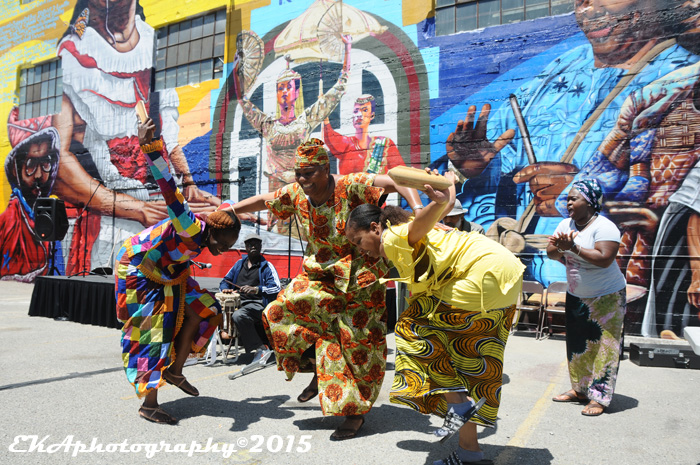
One comment